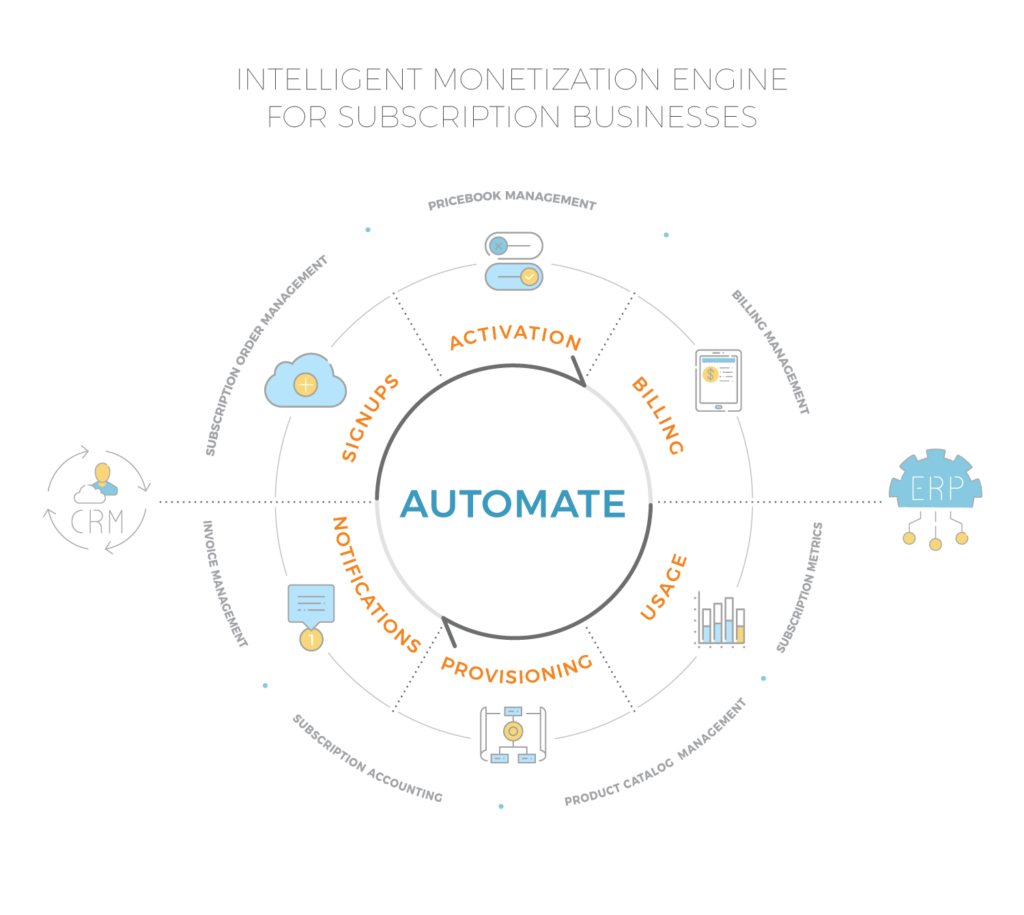Most SaaS businesses struggle to access the right data at the right time. This can take the form of juggling multiple spreadsheets and email threads, or hopping between platforms in your tech stack when compiling information for sales, reports, or day-to-day subscription management.
However, workaround solutions are only effective for so long. As well as being inconvenient, this only leaves plenty of room for error. Eventually, suspect data creeps in and leads to issues that can impact every department, from sales and marketing to finance and customer success—even at the executive level. In turn, this can impact the customer at every stage of their subscription journey.
Why? Because it’s hard to retain the integrity of data spread across multiple systems, tools, and departments. Depending on who has access and whether that data is updated in real-time and synchronized across the board, teams are often left unsure of whether the data they’re using is reliable.
SaaS business teams need one place where accurate data can always be found. Not only that, the data needs to be up-to-date and easily accessible while remaining secure.
In sum, what you need is a single source of truth (SSOT). In this blog, we’re going to cover what an SSOT is, how it benefits subscription businesses, and how you should go about setting one up.
What is a Single Source of Truth (SSOT)?
Single Source of Truth (SSOT) refers to a data management strategy where a single, centralized source of data is used across an entire organization for vital activities like analytics
Put simply, an SSOT is a business’s primary source of accurate, real-time data across all its departments. It’s where teams can go to find the information they need, and be confident that it’s accurate, reliable, and up to date. This then shaves valuable time from planning and information search.
What Makes SSOT a Superior Data Management Strategy?
So, what makes a platform and data system an SSOT? Some businesses consider their customer relationship management (CRM) platform to be an SSOT, for example, or their accounting system or ERP. Yet CRM, accounting software, and ERPs —though vital tools in the modern SaaS tech stack—fall short of meeting all the data needs of a scaling SaaS business.
For example, while a CRM platform is an excellent source of lead and customer information, this information is often live and in continual flux as various individuals within an organization make updates and changes—such as when a customer upgrades or downgrades their subscription plan.
Accounting software presents a different problem. While it provides an accurate, detailed financial history for your business, its design focuses on past data. It’s your system of record for period-end closing.
This leaves a large blind spot when it comes to current, real-time information. It also doesn’t provide any way of automatically or efficiently deriving future predictions about a business.
As for ERPs, their inventory-centered approach is great for creating a linear one-time sales process. However, these systems can struggle to manage the various changes and demands of a recurring revenue stream.
So, as customers move along down the pipeline with your business and their data touches and transfers back and forth between various departments, this leaves lots of room for undermined data integrity. This is particularly true when a SaaS business offers multiple plans and products on a subscription basis that customers can move between in real time, making it very difficult to respond to changing user trends if valuable data is held within data silos.
SaaS businesses need to establish an SSOT capable of offering reliable customer and financial data integrity along with automated revenue forecasting. And in doing so, they can enhance their businesses’ entire subscription management process.
How Does a Single Source of Truth (SSOT) Work?
Centralized data storage
The biggest guiding principle of SSOT is storing all of your vital data in a single dashboard or platform that is accessible to different teams across your subscription business. Otherwise, it’s impossible to have a single source of truth. If fresh data isn’t being consistently added to your SSOT, this undermines the integrity of your database and forces team members to hunt across multiple systems to find up-to-date information.
By centralizing data in this way, it eliminates the risk of SaaS businesses retaining conflicting or outdated data. Because all updates are made within the SSOT itself, it guarantees uniformity across departments and systems.
Accessible by all departments
Owing to different teams using different platforms, there may be strict permissions in place as to which personnel can access which data sets. In practice, this can result in lengthy delays in accessing the right information and making data-driven decisions, especially if another team has to vet the request and gather the data.
An SSOT ensures that authorized users can access all of the stored data whenever they need it, which supports timely decision-making based on accurate data.
Real-time decision-making
Because users only need to access data from a single source instead of several, this makes it possible to retrieve data quickly to support timely, informed decision-making. For example, an SSOT makes it easier for subscription businesses to launch enticing promotions or discounts by responding to real-time customer behavior.
Why the Right SSOT is a Subscription Management Game-changer
Subscription data management means keeping track of highly complex analytics across multiple profiles and subscription plans. This includes customer details, subscription plans, billing information, and churn rate, all of which has a massive influence on business decisions such as pricing and promotions. This is why establishing a single source of truth is vital to ensure that subscription data is being maintained consistently and accurately across different teams to avoid data silos.
By establishing an adaptive recurring billing system not only as your SaaS business’s financial system of record but also as your SSOT for accounts receivable, you can unify your business’s key platforms like your CRM, ERP, and accounting software. This offers your business both financial and customer data integrity, in addition to automation and efficiency to enhance your business’s entire subscription management and monetization process.

Sales and quotes
To maintain accurate billing, the catalog within your recurring billing system must house the most up-to-date data sources regarding your SaaS businesses products, plans, and pricing.
This means for sales and quotation purposes, your team can always rely on this data to provide potential subscription customers with the most accurate information regarding what you offer and what it will cost. This SSOT architecture helps you to avoid misquoting your sales leads, which leads to lost revenue opportunities and confusion for your current customers.
Billing and invoicing
Once a customer has been created in your recurring billing system and pricing is established and even customized as needed billing and invoicing are accurately and automatically rolled out on a recurring schedule.
By creating a set-it-and-forget-it subscription management environment for billing clerks, billing automation resolves the major accounting pain points surrounding recurring billing, including revenue recognition and subscription renewals. This also enhances the customer experience by eliminating billing inaccuracies that stem from manual processes, reducing customer churn due to mistrust.
Customer support
Along the customer journey, your support team members need to be able to confidently rely on your billing system for accurate information on customer cohort revenue.
Using your billing system as your SSOT means they can also access customers’ contact information and subscription history. They can dig into customers’ payment schedules and billing details. Because recurring billing systems generate future invoices, they’re also able to provide customers with details about their upcoming billing cycle and any add-on features they may be subscribed to. Having accurate billing information available as needed makes customers feel valued and confident in your business’s processes, which further boosts customer loyalty.
Customer success
Lifecycle playbooks enable SaaS customer success teams to formalize their retention strategies. But to create these playbooks, they first need to understand what makes their customers churn and what makes them stick around.
A reliable SSOT data source like recurring billing software gives teams access to up-to-date churn and lifetime value (LTV) data to inform playbook-building and actioning.
By establishing a reliable SSOT approach for revenue that’s shared across all departments, everyone has access to the same revenue data and can leverage it to accurately create and manage subscriptions, make data-driven decisions, retain customers, and improve the overall customer experience.
Transforming Your Subscription Management Process with Data Integrity
Establishing a reliable SSOT for revenue is a vital step for any growing SaaS business and its subscription management process. No matter where customers are in their lifecycle, your team needs to be able to leverage the most accurate, up-to-date information on them whenever they need it.
So, if your current SSOT for accounts receivables is only a CRM, accounting platform, or ERP, there’s a good chance you’re missing out on some key insights that could greatly impact your SaaS business for the better.
If you don’t have an established SSOT for financial data at all and you’re struggling to manage data stored in various places, now is the time to consider what a true SSOT solution looks like for your SaaS business.
An adaptive recurring billing platform like Stax serves many functions, such as:
- Automating billing, collections, revenue recognition, and dunning.
- Simplifying reporting and making it easy to track key SaaS metrics like churn, recurring revenue, and lifetime value.
- And most importantly of all, feeding data integrity across your entire SaaS operations.
With up-to-date customer information, accurate billing and financial data, revenue forecasting capabilities and in-depth insight into sales and accounts receivable, it’s hard to imagine a better SSOT for critical business intelligence.
How to Implement SSOT
Identify what data requires an SSOT approach
Before you can begin implementing an SSOT system, you need to define the scope of your SSOT initiative. This starts by understanding what critical subscription data your organization is relying on to refine your operation and product/service offerings.
This may involve customer profiles, subscription plans, billing information, subscription analytics, renewal dates, and any other data that guide critical business decisions and shouldn’t be kept in data silos. This ensures that your SSOT system doesn’t get bogged down with necessary information that slows down implementation and makes data management more difficult.
Understand how your subscription data is currently being stored
If your business currently has multiple data sources that are managed by different teams, this needs to be mapped out in advance of migration so you can plan out the best workflow to centralize your datasets to a single location without loss or duplication.
Identify all of the various systems, data sources, and data warehouses that hold all of the information that will form the backbone of your SSOT. This assessment will help you plan for data migration and ensure a smooth transition.
For example, your CRM is home to all of your past and current customer profiles. However, data on their most recent orders and purchases will likely be held by your Order Management System (OMS). Moving these data sets to a single location will give you a comprehensive overview of customer activities.
Select the right tech stack
Aggregating your subscription data effectively requires finding the right system to support your SSOT goals. Subscription businesses demand a very precise data strategy that brings together financial, marketing, and customer data seamlessly and in one convenient place, as well as enabling features like automated billing and self-service tools that allow customers to adjust their subscriptions.
An adaptive billing solution like Stax Bill enables SaaS business teams to know that they’re deriving insights and making decisions based on accurate data, meaning a better ROI for strategies like marketing and customer engagement.
Migrate your data
Migrating data from multiple sources to your SSOT needs to be planned carefully and accomplished in stages to prevent data from getting lost or duplicated. To minimize errors, it’s a good idea to create a data migration strategy that outlines a step-by-step process, data mapping, and data validation procedures. Using a phased approach by migrating one system at a time helps to minimize any disruptions to business operations and allows for regular check-ins before you launch your SSOT.
Training your users
The success of your SSOT after implementation hinges on how well your teams understand the new system and how they should retrieve data for the best results. Put together a training module on your SSOT system that introduces the overall concept and how teams will benefit from managing data this way. Your module should also cover how to access, add, or retrieve data while preserving the integrity of the architecture.
Transforming your data management strategy from scattered data silos to a centralized SSOT solution is not only about avoiding inaccuracies, but ensuring that different teams across your SaaS business can make strategic decisions using accurate, real-time information.
By implementing an SSOT, subscription businesses no longer have to bounce between their CRM. ERP, or accounting software to build a unified picture of what is happening at their organization; having one place to store all important data makes streamlined, efficient subscription data collection and analysis the norm rather than the exception.
By taking a step-by-step approach to implementing your SSOT and ensuring that you understand your current data collection strategy, you avoid costly mistakes that further cloud data accuracy. Focusing on migrating one system at a time and validating each data set ensures that each team experiences a seamless transition to the new SSOT, setting a good benchmark for future use.
A platform like Stax Bill enables SaaS business teams to know that they’re deriving insights and making decisions and strategies based on accurate data. As SaaS usage continues to grow, so does the value of a refined SSOT that helps subscription businesses reach new levels of data-driven decision-making.
FAQs about SSOT
Q: What is Single Source of Truth (SSOT) in a SaaS environment?
Single Source of Truth (SSOT) in SaaS is a data management strategy in which all the vital data, such as customer profiles, subscription plans, and billing information, is centralized to one place accessible to various teams across the subscription business. This ensures integrity of data and enables timely, accurate, and informed decision-making.
Q: How does SSOT enhance the subscription management process?
By storing all the vital data in one place, SSOT ensures the different teams across a SaaS business can make strategic decisions using accurate, real-time information. Moreover, SSOT allows for the automation of billing and collections, revenue recognition, and tracking key SaaS metrics like churn, recurring revenue, and lifetime value.
Q: Why is it important for a SaaS business to establish SSOT?
Establishing an SSOT prevents data discrepancies arising from having the data spread over multiple systems. It ensures uniformity across all departments and systems, eliminates the risk of conflicting or outdated data, and supports informed decision-making.
Q: Can SSOT contribute to improving customer experience in a SaaS business?
Absolutely. SSOT allows for accurate and real-time billing, efficient management of customer’s subscription plans, and eliminates inaccuracies originating from manual processes, thereby fostering trust in customers which in turn boosts customer loyalty.
Q: What if a SaaS business does not have an established SSOT for financial data?
If not established, the SaaS business might miss out on crucial insights and face difficulties in managing data stored in various places. Neglecting SSOT might lead to undermining data integrity and make it challenging for teams to find up-to-date information.
Q: What is the first step in implementing an SSOT system in a SaaS business?
The first step is understanding the critical subscription data your organization relies on to refine your operations and offerings. Once you’ve identified this, you can plan out the best workflow to centralize your datasets to a single location.
Q: What is a good strategy for migrating data to the SSOT system?
Migrating data to SSOT should be done methodically and in stages to avoid loss or duplication of data. A phased approach, migrating one system at a time, not only minimizes disruptions to business operations but also allows for regular check-ins before launching the SSOT.
Q: How does SSOT contribute to accurate billing in a SaaS business?
In an SSOT, the catalog within your recurring billing system must house the most up-to-date data sources regarding your SaaS business’s products, plans, and pricing. Armed with such accurate information, the team can provide potential subscription customers with the most accurate information regarding what you offer and what it will cost.
Q: Can an accounting platform act as an SSOT for a SaaS business?
While an accounting platform provides accurate financial history, its major limitation lies in its focus on past data. It doesn’t provide any way of automatically deriving future predictions about a business or managing the various changes and demands of a recurring revenue stream.








